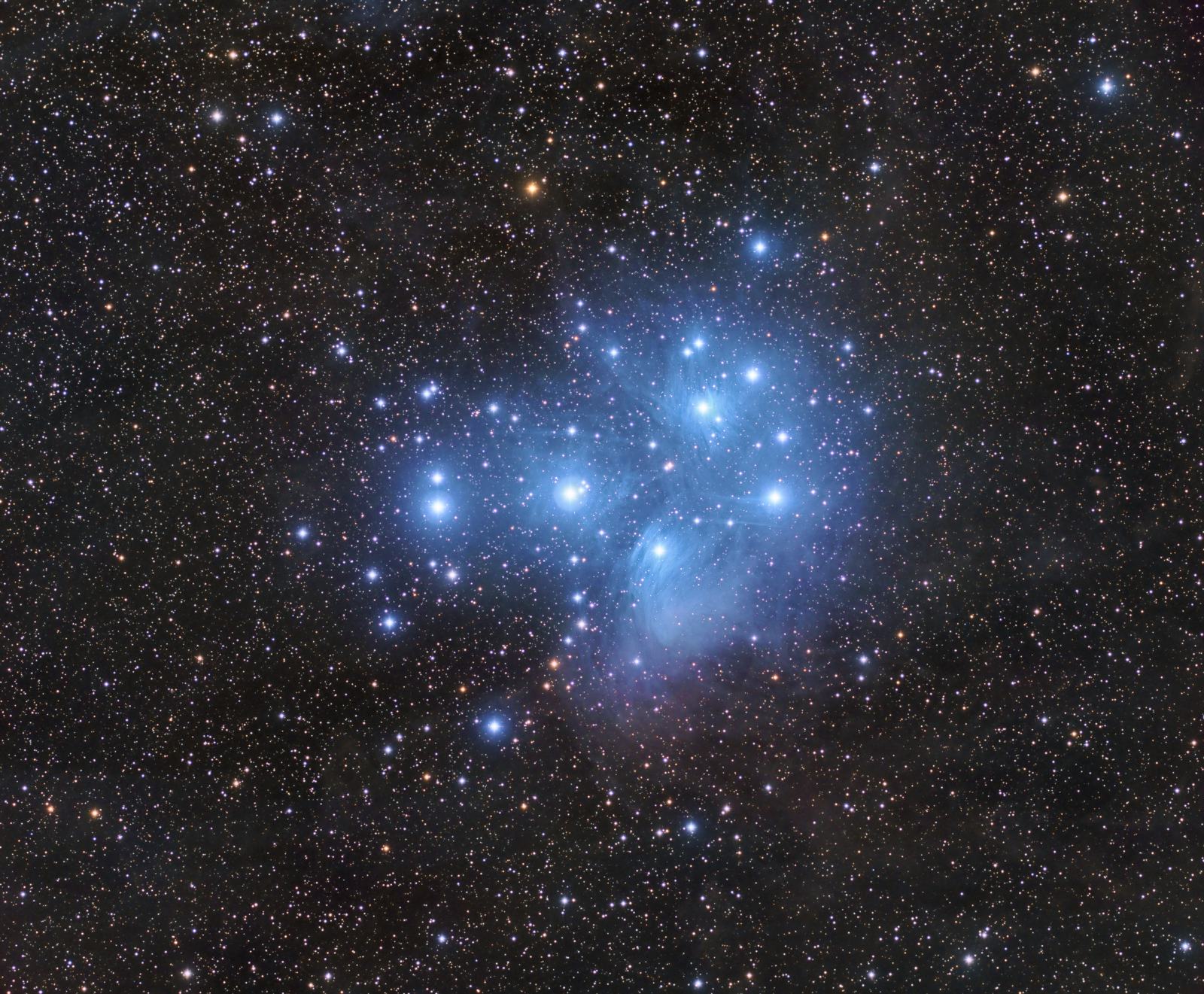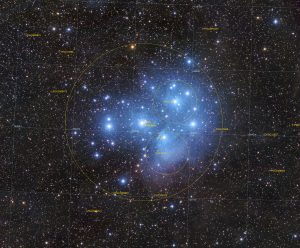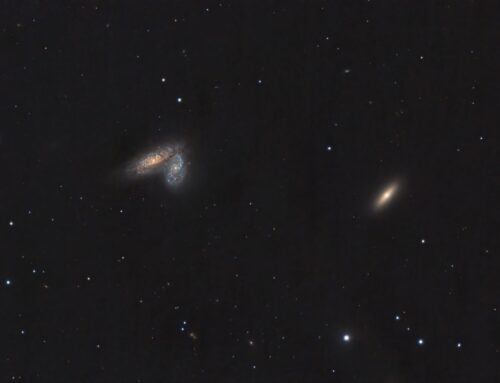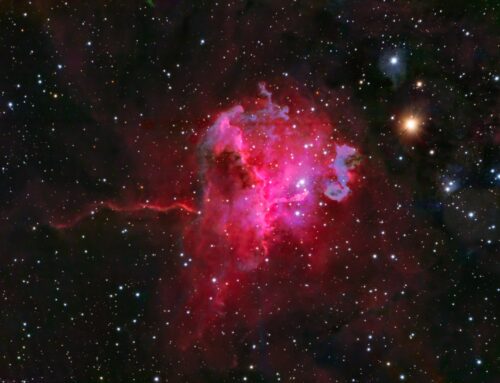M45, The Pleiades Wide Field
 Click image for full size version
Click image for full size version
December 25, 2017
The attached image shows M45, better known as the Pleiades, or the Seven Sisters. In Latin America, it’s called “the Seven Kids”, as in baby goats). The Pleiades was observed and written about long before Messier catalogued it. Galileo published a sketch in 1610 that showed 36 stars that he could see with his telescope. The earliest known depiction of the Pleiades is from is about 17,000 years old: a cave drawing in the Lascaux Cave in France. If you get a chance, have a look at this object through binoculars. It is spectacular and well placed for imaging this time of year.
The blue haze around this star cluster is a reflection nebula – star light is being reflected of soot/dust particles in the background. There’s also some pinkish emission nebula (NGC 1435) in the lower portion of the nebula and dim brownish dust mottling the outer parts of this field (called “cirrus”). M45 is about 440 light years from us and contains at least 1000 members in the cluster. The stars have been estimated to be between 75 and 150 million years old. The brightest cluster stars belong to class B, and are very hot bluish stars.
 Although the Pleiades is the dominant object in this shot, there are also hundreds of galaxies in this field, lying far in the background. I have posted an annotated image that highlights the location of some of them. I encourage you to load the image and zoom in to see the many galaxies in the field. In October 2016 I posted a higher resolution image that shows even more galaxies.
Although the Pleiades is the dominant object in this shot, there are also hundreds of galaxies in this field, lying far in the background. I have posted an annotated image that highlights the location of some of them. I encourage you to load the image and zoom in to see the many galaxies in the field. In October 2016 I posted a higher resolution image that shows even more galaxies.
Tekkies:
Moravian G3-16200 EC camera (on loan from O’Telescope), Optolong R, G and B filters, Takahashi FSQ-106 ED IV at f/3.6, Paramount MX, unguided. Acquisition with the SkyX, focused with FocusMax. Scripted with CCD Commander. All pre-processing and processing in PixInsight. Acquired from my SkyShed in Guelph. No moon; average transparency and seeing.
25x5m R, 29x5m G and 27x5m B unbinned frames (total=6hr45m).
Pre-Processing
The BatchPreProcessing script was used to perform calibration, cosmetic correction and registration of all frames. Blink and SubframeSelector were used to identify the best single exposure for each filter. LocalNormalization and ImageIntegration were applied using the best frames as reference frames. DrizzleIntegration was used to make the channel masters. During ImageIntegration and DrizzleIntegration, the local normalization files (.xnml) were used. The high Large-Scale Removal tool was used in ImageIntegration.
RGB Creation
Creation and cleanup: The R, G, and B masters were cropped. DynamicBackgroundExtraction was applied to each master. R, G and B were combined to make an RGB image which was processed with PhotometricColorCalibration, using a background area as the background reference.
Linear Noise Reduction: MultiscaleLinearTransform was used to reduce noise in the RGB image. The linear mask feature was used to protect bright stars and brighter areas of the nebulae. Layer settings for threshold and strength: Layer 1: 4.0 0.92 Layer 2: 3.0, 0.80 Layer 3: 2., 0.7 Layer 4: 1.0, 0.45 Layer 5: 0.5, 0.2.
Stretching: HistogramTransformation was applied to the RGB image to make a pleasing, bright image.
Synthetic Luminance
Creation and cleanup of SynthL: The three channel masters were integrated (average, noise weighted, no rejection) using ImageIntegration to create the SynthL.
Deconvolution: A star mask was made to use as a local deringing support image. A copy of the image was stretched to use as a range mask. Deconvolution was applied (50 iterations, regularized Richardson-Lucy, external PSF made using DynamicPSF tool with about 30 stars).
Linear Noise Reduction: MultiscaleLinearTransform was used to reduce noise in the background areas of the HaRGB file. Layer settings for threshold and strength: Layer 1: 4.0 0.92 Layer 2: 3.0, 0.80 Layer 3: 2., 0.7 Layer 4: 1.0, 0.45 Layer 5: 0.5, 0.2.
Stretching: HistogramTransformation was applied to the SynthL to make a pleasing, bright image.
Noise Reduction and Re-Stretch: TGVDenoise was applied in Lab mode with 300 iterations with a range mask applied to protect high signal areas. This was followed by a HistogramTransformation to raise the black point (but with no clipping).
Combining SynthL with RGB
The processed SynthL was applied to the RGB image using LRGBCombine.
Additional Processing
Local Contrast Adjustment: HDRMultiscaleTransformation (6 layers, max contrast 1.5, strength 0.3, to Lightness) was applied to a copy of the image using a mask to protect the background and stars. The result was blended with the original 40:60.
Noise Reduction and Re-Stretch: TGVDenoise was applied in Lab mode with 300 iterations with a range mask used to protect high signal areas. This was followed by a HistogramTransformation to raise the black point (but with no clipping).
Final Steps: MultiscaleLinearTransform was used to sharpen the structures in the bright parts of the nebula (layers 2-3 at 0.10). Background, nebula and star brightness, contrast and saturation were adjusted in several iterations using Curves with masks as required. The image was downsampled by a factor of 2 to restore the original resolution.
Image scale is about 3.2 arcsec per pixel for this camera/telescope combination.






Leave A Comment